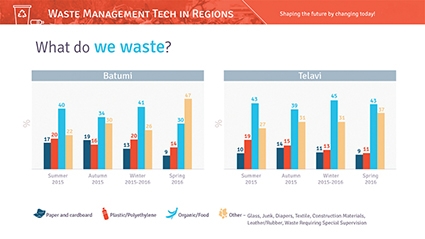What Do We Dump and What Could We Turn into a Resource?
In 2015-2016, a morphological composition study of solid household waste was carried out in Kakheti Region and Adjara AR (Autonomous Republic). The study was held within the Waste Management Technologies in Regions (WMTR) Program implemented by ICMA and CENN in Kakheti and Adjara with the financial support of USAID.
The study has shown that organic materials, paper and plastic are the main waste streams generated in the target regions, their share significantly exceeding other types of waste generated there.
Overall, the largest share (Kakheti – 42.72 percent, Adjara – 36.61 percent) of waste disposed at the dumpsites/landfills of the regions under study falls on organic waste. Considering the results, the need for implementation of a composting practice in the country becomes evident.
Setting up a composting area or using organic waste to obtain fuel in bio-plants is quite possible, provided there is sufficient investment.
There is quite a choice of locations in Kakheti Region where compost could be made from organic waste and then provided to farms. And it is much needed, given the comparatively developed agricultural sector in the region.
Representatives of various enterprises collect plastic, polymeric products, PET bottles and cardboard waste and deliver them to various recycling companies, some of which are not registered or recorded by proper governmental structures. There is a sufficient resource of plastic in the region, and its possible use as a raw material could reduce the volume of plastic in the landfills by at least 10-15%. It should also be noted that collection and re-use of glass waste takes place in a disorderly manner and in violation of the existing norms (Kakheti – 5.95 percent, Adjara – 5.02 percent).
Paper and cardboard waste (Kakheti – 11.19 percent, Adjara – 14.7 percent) is disposed of and buried in landfills. In Adjara, cardboard waste is partially accumulated at commercial facilities and markets, pressed and exported, while only a very small amount of paper waste is treated on the spot. Unfortunately, there are no local recycling companies in Kakheti. Accordingly, due to the lack of recycling companies, the country loses a very important resource.
The situation is a little different in the Adjara AR where seven small productive recycling companies operate, mainly conducting initial treatment and export of recyclables collected from municipal waste in a disorderly manner, which consists of around 20-30 percent of the overall volume of separate components. The small amount of materials is, among other things, conditioned by their quality. Many more resources could be recycled through source separation rather than by sorting recyclables out of mixed waste.
It should be noted that similar composition studies were conducted to identify the morphological composition of municipal waste at the Batumi landfill in 2008-2009. The findings of those studies are completely different from the findings of the studies conducted within WMTR. Current results are close to municipal waste composition established by international standards and existing in numerous other countries.
The results of the 2015-2016 morphological study show that up to 90% of raw materials of various components subject to recycling are buried in the soil. The burial of organic and partially organic waste is accompanied by decomposition and the resulting generation of greenhouse gases, mainly methane and carbon dioxide.
The reduction of greenhouse gas emissions is required by the Framework Convention on Climate Change.
Gas generation from organic waste disposed of in the landfill normally starts several months after waste disposal and continues throughout the entire life cycle of the landfill; after the burial of waste, the complete period of gas emission from organic waste at the landfill is almost 70 years. This is why it is essential to implement various activities and to create waste recycling companies of various types and characteristics.
Baia Dzagnidze












